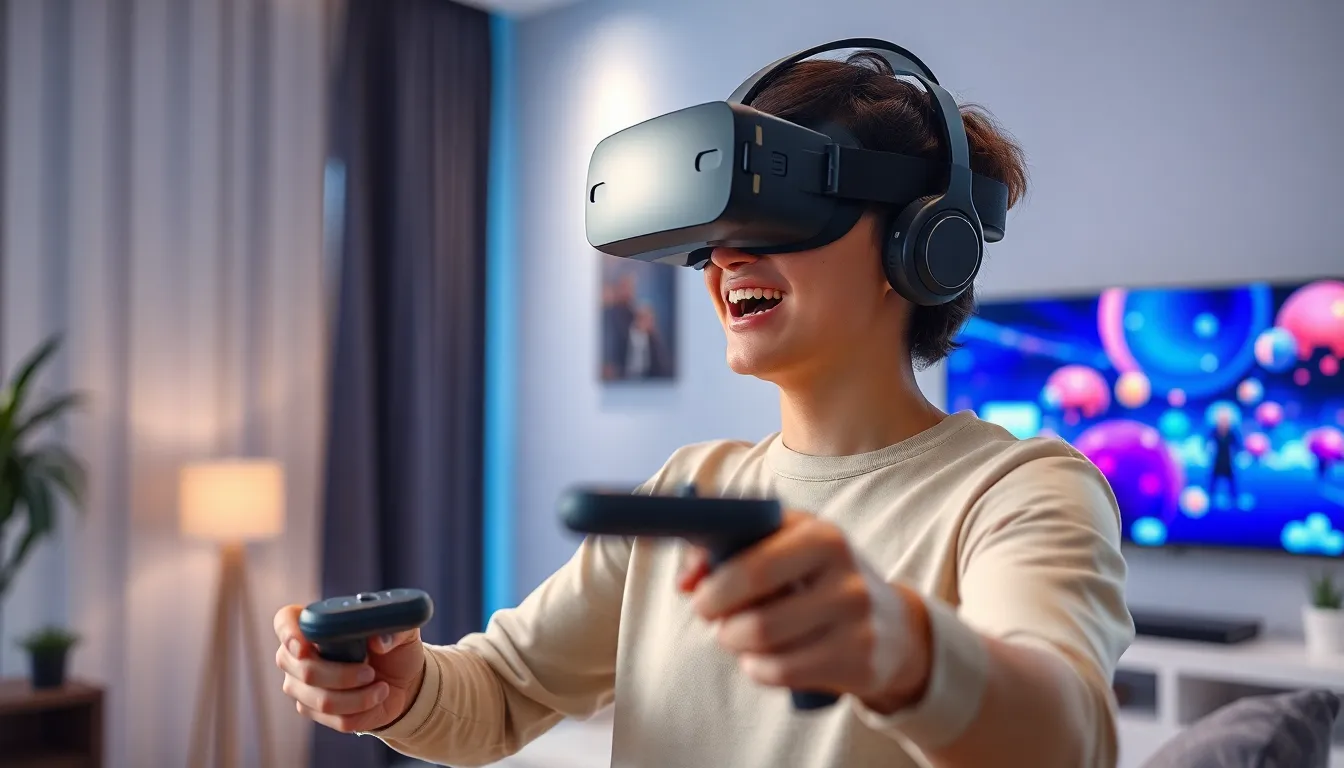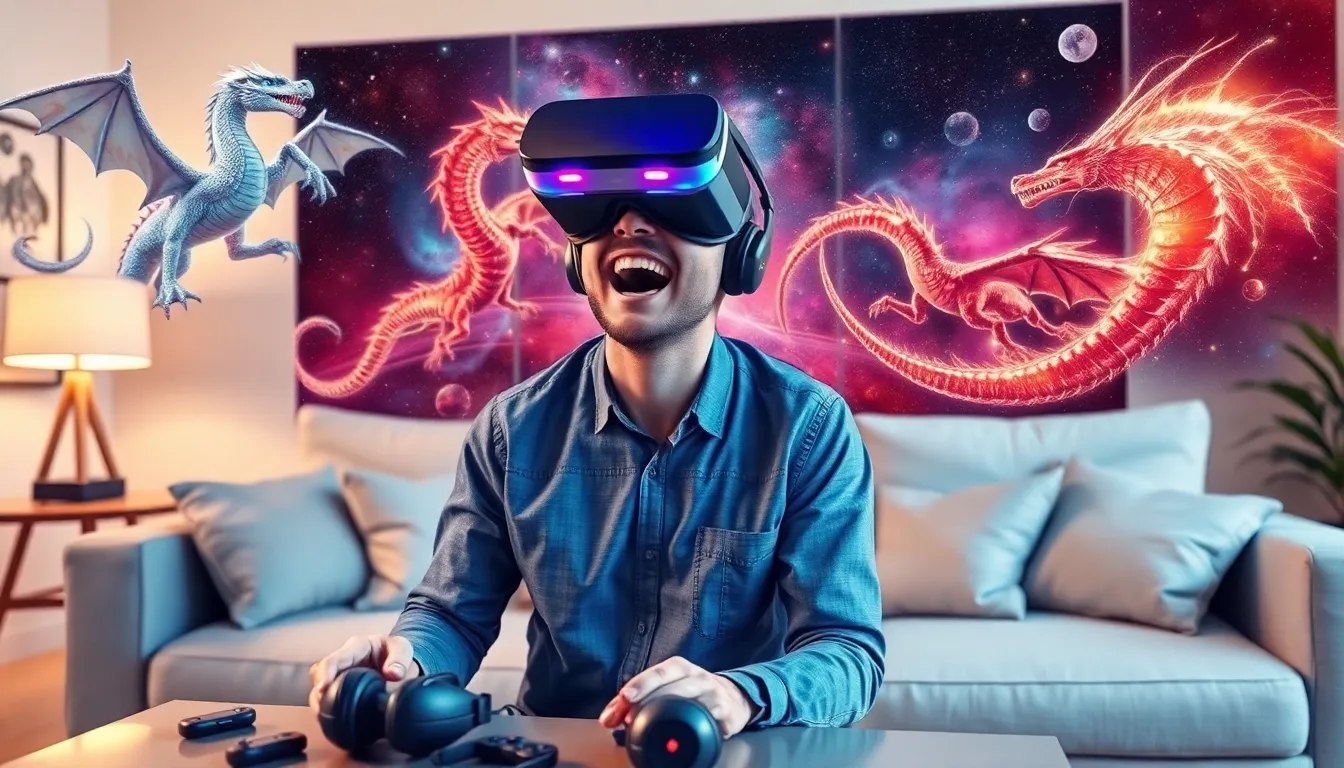In a world where reality sometimes feels a bit too… well, real, virtual reality (VR) equipment swoops in like a superhero with a cape made of pixels. Imagine strapping on a headset and diving into a universe where you can battle dragons, explore distant galaxies, or even attend a concert without the hassle of finding parking. It’s not just a gaming tool; it’s an escape hatch from the mundane.
Table of Contents
ToggleOverview of VR Equipment
VR equipment consists of several key components that enhance the virtual experience. Headsets serve as the primary devices, providing immersive visuals and audio. Popular models include the Oculus Quest 2, HTC Vive Pro, and Valve Index, each offering unique features for various users.
Controllers provide the means for interaction, enabling users to manipulate objects within the virtual environment. Motion-tracking technology ensures accuracy while capturing hand movements and gestures. This technology enhances engagement and realism during gameplay or exploration activities.
Tracking systems play a crucial role in defining the VR experience. Inside-out tracking employs sensors within the headset to monitor movement, while outside-in tracking uses external sensors placed within the environment. These tracking methods facilitate seamless navigation in three-dimensional spaces.
Additionally, accessories improve comfort and usability. Items such as VR gloves enhance tactile feedback, allowing users to feel sensations in digital worlds. Audio accessories, like high-quality headphones, immerse users further by delivering spatial sound.
PC-based VR systems require robust hardware specifications to support high-resolution graphics and smooth performance. Compatible gaming PCs typically feature powerful GPUs and CPUs to meet demanding requirements. Standalone VR headsets, however, operate independently without additional hardware, making them a more accessible choice for casual users.
Content availability also influences the VR experience. Numerous platforms, including SteamVR and the Oculus Store, offer a range of games and experiences. Users can explore educational programs, simulations, or social platforms designed specifically for VR environments.
VR equipment evolves rapidly, showcasing advancements in technology and design. The integration of augmented reality elements into VR devices is gaining attention, allowing users to blend virtual elements with the real world. As innovation continues, the future of VR equipment promises even more immersive experiences.
Types of VR Equipment

Various types of VR equipment enhance the immersive experience, each serving a unique purpose within the virtual realm.
Head-Mounted Displays (HMDs)
Head-mounted displays, such as the Oculus Quest 2 and HTC Vive Pro, provide immersive visuals and audio. These devices fit securely over the eyes, creating a three-dimensional environment. Users experience a wide field of view, allowing them to explore worlds filled with stunning graphics. Built-in audio systems further enhance engagement by delivering spatial sound. Comfort remains a crucial factor; therefore, many HMDs feature adjustable straps and lightweight designs. Ultimately, the performance of HMDs significantly impacts the overall VR experience.
Motion Controllers
Motion controllers enable interactions within virtual environments. Devices like the Valve Index controllers offer precise tracking of hand movements, giving users greater control. When grasped, these controllers mimic real-world actions, allowing for natural movements in games and experiences. Each controller typically features buttons and triggers that enhance functionality, offering various ways to interact. In many instances, haptic feedback provides tactile sensations, further deepening immersion. Users find that motion controllers are essential for an engaging VR experience.
Tracking Systems
Tracking systems facilitate seamless navigation in three-dimensional spaces. Inside-out tracking originates from the headset itself, utilizing built-in sensors to track movement without external devices. Outside-in tracking relies on external sensors placed in the environment to capture user movements. Both methods serve to ensure accurate positioning within the virtual space, allowing for fluid transitions between different experiences. Choosing the right tracking system significantly influences the level of immersion users feel. Advanced tracking technologies evolve continually to enhance user experience and offer even more accurate tracking capabilities.
Key Features to Consider
When evaluating VR equipment, specific features play a crucial role in the overall experience. Focus on the following elements to make an informed decision.
Resolution and Display Quality
Resolution directly impacts visual clarity. Higher pixel counts enhance immersion by reducing the screen-door effect. Display technology, such as OLED or LCD, affects color depth and contrast. Most modern headsets offer resolutions between 1080p and 8K to provide crisp visuals. Moreover, advanced displays reduce latency and motion blur, creating a seamless experience. Users should consider headsets with higher refresh rates to maintain fluidity during fast movements.
Field of View and Refresh Rate
Field of view (FOV) defines how much of the virtual world users can see at once. A wider FOV enhances the immersive experience, allowing users to feel more engaged. Typically, FOVs range from 90 degrees to 120 degrees. Refresh rate, measured in hertz (Hz), indicates how often the image refreshes per second. Higher refresh rates, like 90Hz or 120Hz, reduce motion sickness and enhance realism. Balancing these two aspects improves user comfort during prolonged sessions.
Comfort and Ergonomics
Comfort influences the usability of VR equipment during extended sessions. Headsets should distribute weight evenly to prevent strain. Adjustable straps and padding enhance the fit and comfort for diverse users. Ergonomics also includes designs that accommodate glasses or other personal adjustments. Additionally, ventilation systems help reduce heat buildup during use. Users should prioritize lightweight headsets that provide stable fittings for an enjoyable experience.
Popular VR Equipment Brands
VR equipment brands continuously drive innovation and improve user experiences. Developers focus on enhancing features while expanding accessibility. Here are some leading brands in the VR landscape:
Oculus
Oculus stands out for its intuitive design and affordability. The Oculus Quest 2, in particular, offers a wireless experience with impressive graphics. Users appreciate its ease of setup and extensive game library available on the Oculus Store. They enjoy both casual and immersive gaming options, making it a popular choice among newcomers and experienced VR enthusiasts. The integration of hand tracking further enhances user interaction through natural movements.
HTC Vive
HTC Vive delivers high-end VR experiences aimed at gamers and professional users. The HTC Vive Pro features superior graphics and audio quality, creating a truly immersive virtual environment. Users benefit from precise tracking through external sensors, allowing them to explore large play areas seamlessly. The Viveport platform offers a diverse selection of games and experiences designed to showcase the hardware’s capabilities. Its commitment to high performance positions HTC as a leader in the premium VR segment.
Sony PlayStation VR
Sony PlayStation VR appeals to console gamers seeking an accessible entry into VR. Compatible with PlayStation 4 and PlayStation 5, it provides a library of exclusive titles. Users enjoy the familiar gaming ecosystem combined with a comfortable headset design. The PlayStation VR aims to bring immersive experiences to a broader audience by leveraging its established user base. Affordable pricing and bundled games make it an attractive option for both casual and devoted gamers.
The landscape of virtual reality continues to evolve rapidly offering users an unparalleled gateway to immersive experiences. With advancements in VR equipment and technology users can explore new worlds engage in thrilling activities and enhance their overall enjoyment.
As brands innovate and introduce more accessible options the future of VR looks promising. Whether for gaming education or social interaction VR equipment is set to redefine how individuals connect with digital content. The possibilities are endless and those who embrace this technology will undoubtedly find themselves at the forefront of a new digital frontier.



